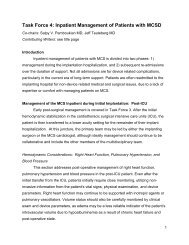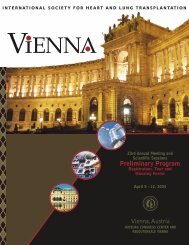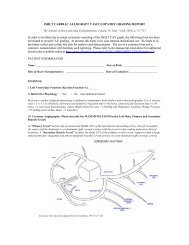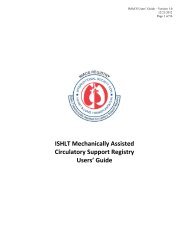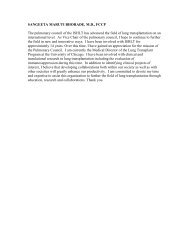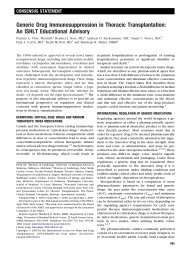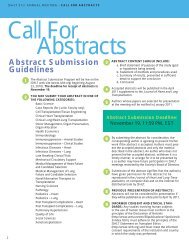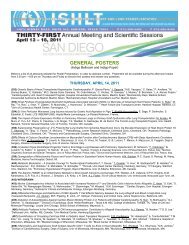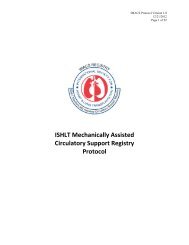Guidelines for the care of heart transplant recipients
Guidelines for the care of heart transplant recipients
Guidelines for the care of heart transplant recipients
Create successful ePaper yourself
Turn your PDF publications into a flip-book with our unique Google optimized e-Paper software.
Costanzo et al.<br />
<strong>Guidelines</strong> <strong>for</strong> Heart Transplant Care<br />
941<br />
Table 15 Conversion <strong>of</strong> Oral to Intravenous Doses <strong>of</strong><br />
Immunosuppressive Drugs<br />
Cyclosporine<br />
Tacrolimus<br />
Mycophenolate<br />
m<strong>of</strong>etil<br />
Azathioprine<br />
One-third <strong>of</strong> oral daily dose<br />
ei<strong>the</strong>r as a continuous<br />
infusion over 24 hours,<br />
or divided into two 6-<br />
hourly infusions twice<br />
daily<br />
One-fifth <strong>of</strong> <strong>the</strong> oral daily<br />
dose as a continuous<br />
infusion over 24 hours<br />
Same as oral dose<br />
Same as oral dose<br />
1. HT <strong>recipients</strong> requiring intercurrent surgical procedures<br />
should have a full pre-operative assessment in collaboration<br />
with <strong>the</strong> <strong>transplant</strong> team, particularly in preparation<br />
<strong>for</strong> major procedures requiring general or regional<br />
anes<strong>the</strong>sia.<br />
Level <strong>of</strong> Evidence: C.<br />
2. For many surgical procedures, prophylactic anti-biotic<br />
administration is now <strong>the</strong> norm. Protocols may need<br />
modification in HT <strong>recipients</strong>. Aminoglycoside anti-biotics<br />
and erythromycin are best avoided because <strong>of</strong> <strong>the</strong><br />
risk <strong>of</strong> worsening renal dysfunction when used in combination<br />
with CYA or TAC.<br />
Level <strong>of</strong> Evidence: C.<br />
3. When needed, blood products used in HT <strong>recipients</strong><br />
should be leukocyte poor. ABO-incompatible infant HT<br />
<strong>recipients</strong> require specialized blood products and must<br />
be discussed with <strong>the</strong> <strong>transplant</strong> center.<br />
Level <strong>of</strong> Evidence: C.<br />
4. Anes<strong>the</strong>sia can be safely induced provided that <strong>the</strong>re is<br />
clear understanding that <strong>the</strong> HT is denervated. The resting<br />
<strong>heart</strong> rate is usually higher in HT <strong>recipients</strong>. Although<br />
most allografts have a resting <strong>heart</strong> rate <strong>of</strong> approximately<br />
90 beats/min, some have resting sinus rates<br />
as high as 130 beats/min, which do not require treatment.<br />
It must be remembered that a relative, symptomatic,<br />
bradycardia that requires treatment will not respond to<br />
atropine. Isoproterenol infusion and pacing are <strong>the</strong> usual<br />
modes <strong>of</strong> management <strong>of</strong> HT bradyarrhythmias. Although<br />
uncommon, <strong>the</strong> likeliest sustained atrial arrhythmia<br />
is atrial flutter. Likewise, <strong>the</strong> denervated <strong>heart</strong> is<br />
super-sensitive to adenosine, and <strong>the</strong> use <strong>of</strong> standard<br />
doses to treat atrial tachyarrhythmias may result in prolonged<br />
asystole. Amiodarone is recommended as <strong>the</strong><br />
drug <strong>of</strong> choice <strong>for</strong> atrial tachyarrhythmias in HT <strong>recipients</strong>.<br />
Level <strong>of</strong> Evidence: C.<br />
5. Care with fluid balance is important because decreased<br />
intravascular volume will exacerbate renal dysfunction,<br />
and fluid excess may not be well tolerated by HT <strong>recipients</strong>.<br />
For major surgery, CVP monitoring may be necessary.<br />
Level <strong>of</strong> Evidence: C.<br />
6. Immunosuppression should not be discontinued or omitted<br />
without discussion with <strong>the</strong> HT team. However, it<br />
may be prudent to omit <strong>the</strong> dose <strong>of</strong> CNI on <strong>the</strong> morning<br />
<strong>of</strong> surgery to avoid potentiating <strong>the</strong> detrimental effect <strong>of</strong><br />
dehydration on renal function. Thereafter, immunosuppression<br />
should be continued as normal. If medications<br />
cannot be given orally CYA should be given IV (<strong>of</strong>ten as<br />
a 6-hour infusion every 12 hours or as a continuous<br />
infusion over 24 hours) at a third <strong>of</strong> <strong>the</strong> daily oral dose;<br />
TAC can be given IV at a dose one-fifth <strong>of</strong> <strong>the</strong> total daily<br />
oral dose over 24 hours; AZA should be given IV once<br />
daily at <strong>the</strong> same dose as that taken orally; MMF can be<br />
given IV at <strong>the</strong> same dose taken orally.<br />
Level <strong>of</strong> Evidence: C.<br />
Topic 13: Return to Work or School and<br />
Occupational Restrictions After Heart<br />
Transplantation<br />
Recommendations on Return to Work or School and Occupational<br />
Restrictions After Heart Transplantation: 370–372<br />
Class IIa:<br />
1. Health <strong>care</strong> providers should know that return to work<br />
<strong>for</strong> HT <strong>recipients</strong> is possible, and not passively support<br />
<strong>the</strong> sick role <strong>of</strong> patients.<br />
Level <strong>of</strong> Evidence: C.<br />
2. Return to work should be discussed be<strong>for</strong>e HT as <strong>the</strong><br />
goal <strong>of</strong> post-operative rehabilitation, and not as an exception.<br />
Level <strong>of</strong> Evidence: C.<br />
3. Patients should be encouraged to maintain <strong>the</strong>ir jobs as<br />
long as possible be<strong>for</strong>e HT because this facilitates return<br />
to work after HT.<br />
Level <strong>of</strong> Evidence: C.<br />
4. Short-term and long-term goals <strong>for</strong> returning to work<br />
should be discussed as part <strong>of</strong> <strong>the</strong> discharge planning<br />
after HT.<br />
Level <strong>of</strong> Evidence: C.<br />
5. An employment specialist (eg, a social worker) should<br />
be appointed who can set up a proactive employment<br />
atmosphere and facilitate <strong>the</strong> return to work process after<br />
HT.<br />
Level <strong>of</strong> Evidence: C.<br />
6. This employment specialist should (1) per<strong>for</strong>m a <strong>for</strong>mal<br />
assessment <strong>of</strong> <strong>the</strong> patient’s educational backgrounds,<br />
skills, beliefs, functional and physical limitations, and<br />
<strong>for</strong>mer work experiences; (2) <strong>for</strong>mulate a <strong>care</strong>er plan<br />
with <strong>the</strong> patient that may help <strong>the</strong> patient to enter or<br />
rejoin <strong>the</strong> work <strong>for</strong>ce or acquire fur<strong>the</strong>r vocational training;<br />
(3) have knowledge <strong>of</strong> <strong>the</strong> job market and collaborate<br />
with <strong>the</strong> HT team in learning which physical limitations<br />
<strong>of</strong> <strong>the</strong> patient must be taken into account; (4)<br />
educate future employers about HT and share insights<br />
about an individual patient’s abilities and restrictions in<br />
view <strong>of</strong> post-operative rehabilitation.<br />
Level <strong>of</strong> Evidence: C.



